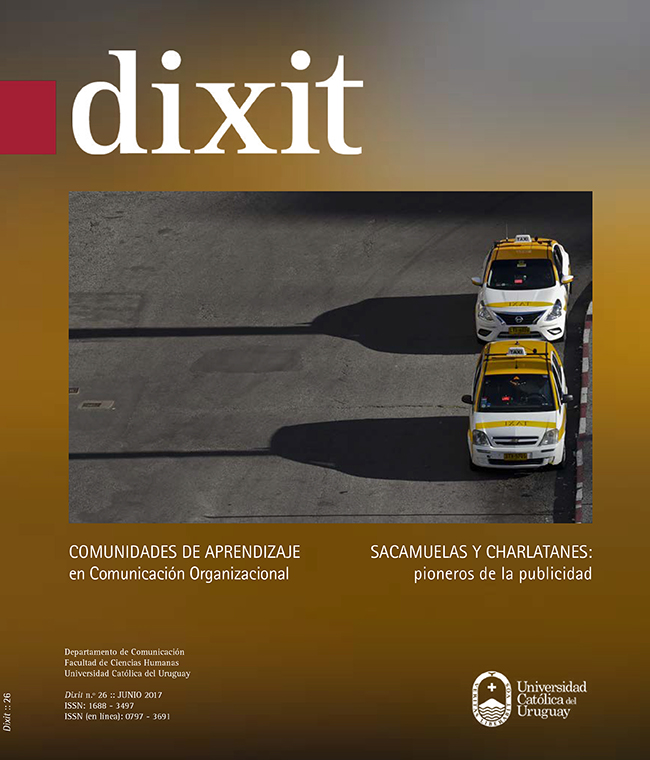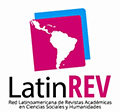Learning Communities in Organizational Communication: A case study
DOI:
https://doi.org/10.22235/d.v0i26.1258Keywords:
higher education, distance education, collaborative learning, educational environment, participationAbstract
This paper analyzes an on-line course from the Organizational Communication Postgraduate Studies in the Universidad Católica del Uruguay, as a virtual learning community using the Computer Supported Collaborative Learning (CSCL) approach. The research methodology was blended, both quantitative and qualitative, with a descriptive-interpretative case study design. Two complementary levels of analysis were set for the discussion forums: participation and discourse analysis. The Community of Inquiry Model was utilized for the discourse analysis. Following the indicators proposed for the cognitive, teaching and social presence, a codification guided by concepts was performed. The categories and indicators of the cognitive presence showed evidence of understanding of the topics developed in the forums. The categories analyzed for the teaching presence permitted the identification of principles related to good practices. The social presence indicators pointed out the importance of the group cohesion and suggested the existence of empathic attitudes and collaboration processes, complementing the observations for the cognitive presence.
Downloads
References
Área, M., San Nicolás, M. B., y Fariña, E. (2010). Buenas prácticas de aulas virtuales en la docencia universitaria semipresencial. Revista Teoría de la Educación: Educación y Cultura en la Sociedad de la Información, 11(1), 7-31. Recuperado de: http://revistatesi.usal.es/~revistas_trabajo/index.php/revistatesi/article/view/5787/5817
Bain, K. (2007). Lo que hacen los mejores profesores universitarios (O. Barberá, Trad.). Valencia, España: Universitat de Valencia.
Cid, A., Zabalza, M. A., y Doval, M. I. (2012). La docencia universitaria: un modelo para su análisis. Revista de Docencia Universitaria, 10(1), 87-104.
Brown, J. S., y Duguid, P. (1991). Organizational Learning and Communities-of-Practice: Toward a Unified View of Working, Learning, and Innovation. Organization Science, 2(1), 40-57.
Castells, M. (s/a). Internet y la sociedad red. Lección inaugural del programa de doctorado sobre sociedad de la información y el conocimiento de la UOC. Recuperado de: http://www.uoc.edu/web/cat/articles/castells/castellsmain1.html
Chávez, J., y Romero, M. (2012). Group awareness, learning, and participation in Computer Supported Collaborative Learning (CSCL). Procedia - Social and Behavioral Sciences, 46, 3068-3073. doi:10.1016/j.sbspro.2012.06.012
Chávez, J., Montaño, R., y Barrera, R. (2016). Structure and content of messages in an online environment: An approach from participation. Computers in Human Behavior, 54, 560-568.
Chickering, A. W., y Gamson, Z. F. (1987). Seven Principles for Good Practice in Undergraduate Education. The American Association for Higher Education Bulletin. Recuperado de: http://www.lonestar.edu/multimedia/SevenPrinciples.pdf
Czerwonogora, A., y Leymonié, J. (2015). Planificando clases que promuevan la comprensión en el Postgrado en Comunicación Organizacional. II Jornadas de Investigación en Educación Superior. Recuperado de: http://www.cse.csic.edu.uy/cdjies/files/poster/6.%20Czerwonogora.pdf
Dewey, J., y Childs, J. L. (1981). The underlying philosophy of education. En J. A. Boydston (Ed.), John Dewey: The later works, 1925-1953, Vol. 8 (pp. 77-103). Carbondale, Il: Southern Illinois University Press.
Garrison, D. R., y Anderson, T. (2005). El e-learning en el siglo XXI. Barcelona, España: Octaedro.
Garrison, D.R., Anderson, T., y Archer, W. (2000). Critical Inquiry in a Text-based Environment: Computer Conferencing in Higher Education. The Internet and Higher Education, 2(2-3), 87-105.
Goetz, J. P., y LeCompte, M. D. (1988). Etnografía y diseño cualitativo en investigación educativa. Madrid, España: Morata.
Gibbs, G. (2012). El análisis de datos cualitativos en la investigación cualitativa. Madrid, España: Morata.
Goggins, S.P., Jahnke, I., y Wulf, V. (2013). Computer-Supported Collaborative Learning at the Workplace. New York, NY: Springer.
Gros, B. (2008). Aprendizajes, conexiones y artefactos. La producción colaborativa del conocimiento. Barcelona, España: Gedisa.
Hiltz, S. R. (1986). The ‘‘virtual classroom’’: using computer-mediated communication for university teaching. Journal of Communication, 36(2), 95-104.
Hrastinski, S. (2008). What is online learner participation? A literature review. Computers & Education, 51, 1755-1765.
Hrastinski, S. (2009). A theory of online learning as online participation. Computers & Education, 52, 78-82.
Joksimovic, S., Kovanovic, V., Skrypnyk, O., Gasevic, D., Dawson, S., y Siemens, G. (2015). The history and state of online learning. En G. Siemens, D. Gašević, y S. Dawson (Eds.), Preparing for the digital university: a review of the history and current state of distance, blended, and online learning (pp. 93-131). Recuperado de: http://linkresearchlab.org/PreparingDigitalUniversity.pdf
Lave, J., y Wenger, E. (1991). Situated learning: legitime peripheral participation. Cambridge UK,: Cambridge University Press.
Leymonié, J., y Bentancur, L. (2013). Modelos de enseñanza de las Ciencias Agrarias. Proyectos de Investigación para la Mejora de la Calidad de la Docencia Universitaria. Comisión Sectorial de Enseñanza – Comisión Sectorial de Investigación Científica. Recuperado de: http://www.fagro.edu.uy/docs/uensenia/otros/Proyecto%20Modelos%20de%20Ense%C3%B1anza%20de%20las%20Ciencias%20Agrarias.pdf
Lipman, M. (1991). Thinking in education. Cambridge UK,: Cambridge University Press.
Lipponen, L. (2002). Exploring foundations for computer-supported collaborative learning. En G. Stahl (Ed.), Computer support for collaborative learning: Foundations for a CSCL community. Proceedings of the Computer-Supported Collaborative Learning 2002 Conference (pp. 72-81). Hillsdale, NJ: Erlbaum.
Pea, R. (1993). Practices of distributed intelligence and designs for education. En G. Salomon (Ed.), Distributed cognitions: Psychological and educational considerations (pp. 47-87). Cambridge, MA: Cambridge University Press.
Perkins, D. (1993). Person-plus: A distributed view of thinking and learning. En G. Salomon (Ed.), Distributed cognitions: Psychological and educational considerations (pp. 88–110). Cambridge, MA: Cambridge University Press.
Perkins, D. (1995). La escuela inteligente. Del adiestramiento de la memoria a la educación de la mente. Barcelona, España: Gedisa.
Perkins, D. (1999). ¿Qué es la Comprensión? En M. Stone Wiske (Comp.), La Enseñanza para la Comprensión. Vinculación entre la investigación y la práctica (pp. 69-92). Buenos Aires, Argentina: Paidós.
Puntambekar, S., Erkens, G., y Hmelo-Silver, C. E. (2011). Analyzing Interactions in CSCL. Methods, Approaches and Issues. New York, NY: Springer.
Rourke, L., Anderson, T., Garrison, D. R., y Archer, W. (2001). Methodological issues in the content analysis of computer conference transcripts. International Journal of Artificial Intelligence in Education, 12, 8-22.
Sanz, S. (2013). Las comunidades de práctica son tendencia. COMeIN, 19. Recuperado de: http://goo.gl/QQIZUb
Schrire, S. (2006). Knowledge building in asynchronous discussion groups: Going beyond quantitative analysis. Computers & Education, 46(1), 49-70.
Segura, M. (2009). Panorama internacional de las TIC en la educación.
Barreras actuales y propuestas de futuro. TELOS, 78. Recuperado de: https://telos.fundaciontelefonica.com/telos/articulocuaderno.asp@idarticulo=3&rev=78.htm
Sherry, L., Billig, S. H., y Tavalin, F. (2000). Good online conversation: building on research to inform practice. Journal of Interactive Learning Research, 11(1), 85-127.
Stahl, G. (2002). Contributions to a Theoretical Framework for CSCL. En G. Stahl (Ed.), Computer support for collaborative learning: Foundations for a CSCL community. Proceedings of CSCL 2002 (pp 62-71). Boulder, CO: Lawrence Erlbaum Associates.
Stake, R. (2013). Estudios de caso cualitativos. En N. K. Denzin, e Y. S. Lincoln (Coords.), Manual de Investigación Cualitativa Volumen III. Las estrategias de investigación cualitativa (pp. 154-197). Barcelona, España: Gedisa.
Strauss, A., y Corbin, J. (1998). Basics of Qualitative Research. California, CA: Sage Publications.
Vygotsky, L. S. (1962). Thought and language. New York, NY/Londres, Inglaterra: Wiley/MIT Press.
Vygotsky, L. S. (1978). Mind in society: The development of higher psychological processes. Cambridge, MA: Harvard University Press.
Yücel, U. A., y Usluel, Y. K. (2016). Knowledge building and the quantity, content and quality of the interaction and participation of students in an online collaborative learning environment. Computers & Education, 97, 31-48.
Wenger, E. (1998). Communities of practice: Learning, meaning and identity. Cambridge, MA: Cambridge University Press.
Wenger, E., McDermott, R., y Synder, W.M. (2002). Cultivating Communities of Practice: A Guide to Managing Knowledge. Boston, MA: Harvard Business School Press.
Downloads
Published
How to Cite
Issue
Section
License

This work is licensed under a Creative Commons Attribution-NonCommercial 4.0 International License.
From issue number 32 onwards all contents are licensed under the Creative Commons Attribution 4.0 International License (CC BY 4.0).
Issues number 29-31 are licensed under the Creative Commons Attribution-NonCommercial 4.0 International License.
The contents corresponding to number 28 and earlier editions are under the Creative Commons Attribution-NonCommercial-ShareAlike 4.0 International License.


















